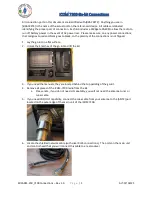
18
To change the gateway address:
Select the “gway” menu item to enter the gateway address menu. To change the gateway
address, use the ▲ and
buttons to select the number (byte) of the gateway address that needs
to be changed (see figure 4.5). The selected number is the number that is underlined. To change
the number, press the
button, the lower digit of the number will start blinking and can now be
changed using the ▲ and
buttons. Press the
again to select another number. The “default”
menu item will set the gateway address to the most likely address based upon the current IP
address and the net mask (the IP address and net mask are “and” together to form a base
address, the gateway is then supposed to be at this base a 1).
To reset the web interface password:
Select the “rst_pass” menu item to reset the web interface password to its default value. For
more information about the web interface password, see
paragraph 4.3.1
.
4.1.5 Info functions
From the top menu, select the “recv” menu item to enter the receiver menu. Then, from the
receiver menu, select the “info” menu item to enter the information menu
The info menu shows some miscellaneous receiver statistics that may be useful in the case of
transmission problems. To exit the information menu, press the
button.
The info menu has two “screens” that can be rotated through by pressing the ▲ and
buttons.
The two “screens” are:
Act. frequency
This screen shows the actual frequency at which the buoy is currently being received. The actual
frequency may be different from the defined reception frequency. This is due to frequency
errors caused by, for example, temperature drifting in the buoy transmitter. This is normal
behaviour and no reason for concern.
Signal status
This screen shows the quality of the incoming signal by two parameters.
FER is the frame error rate; it tells how many percent of the incoming data vectors have one or
more bit errors. IFD is a measure for the frequency deviation of the signal in Hz.
Under normal circumstances FER < 5% and IFD < 15Hz (approximately).
4.2 Receiving data
When the receiver is not in the configuration mode, the status of the data receiving process is
shown on the display (see figure 4.6). The display shows the current receiver mode (see
paragraph 4.1.3
), receiver status and signal quality.
To correctly receive and decode data, the receiver must first “synchronize” with the buoy signal.
The status of this process is shown by the messages on the display. There are four messages
defined:
“synchronizing”
This message indicates that the receiver is synchronizing. This message appears after the
receiver has been switched on, after the receiving frequency has been changed, after the
receiver mode has been changed or when the receiver has lost the buoy signal.
“heave:
153
cm”
This message (see figure 4.6) indicates that the receiver is correctly synchronized and
receiving data. The heave value is the actual, real-time vertical displacement of the buoy.
Содержание RX-C4
Страница 4: ...4 ...
Страница 6: ...6 ...
Страница 8: ...8 ...
Страница 14: ...14 ...
Страница 26: ...26 ...
Страница 28: ...28 ...
Страница 40: ...40 Appendix D Receiving antennas Standard groundplane antenna Figure D1 Standard groundplane antenna ...
Страница 42: ...42 Figure D3 Directional quarter wave antenna ...
















































